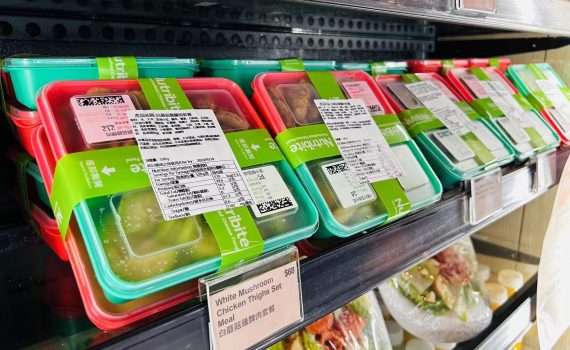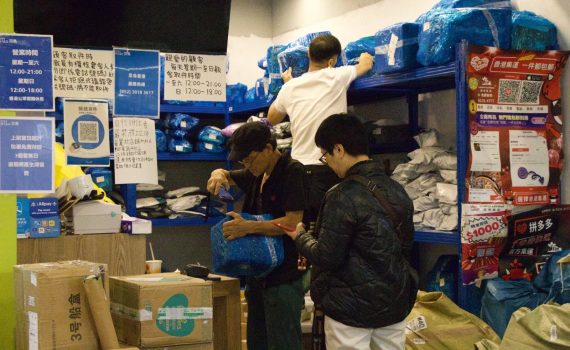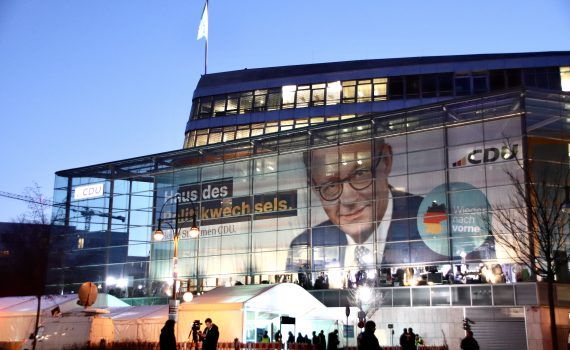The Young Reporter

Golden Horse Best Actress playing deaf girl brings attention to vulnerable group films
- 2025-03-04
- Business
- The Young Reporter
- By: ZHAO Runtong、XIA FanEdited by: XIA Fan
- 2025-03-04
Chung Suet-ying, winner of the Golden Horse Film Best Leading Actress, called for more attention to be allocated to locally independent films while thanking fans supporting the film The Way We Talk at the special screening of Hong Kong Baptist University Communication School, her alma mater. The movie explores the choice of hearing-impaired people between using cochlear implants(electronic devices to improve hearing) or simply using sign language. Sophie Fong, played by Chung Suet-ying, was such a girl getting confused between the two advocacies and later decided to follow inner voices for living her own life. As of March 3, the movie achieved a box office of HK$ 5.35 million, ranking the fourth among all movies that have been released locally within the month. Also, nearly 60% of the audience on the Internet Movie Database (IMDB) gave the movie a score above or at eight out of ten. As for awards winning, besides Chung locking in the "Best Leading Actress" at the Golden Horse Film Awards, the movie also secured the Audience Choice Award and the Hong Kong Film Critics Society Recommended Movies Award. "Some worried a movie about ‘deaf people’ will not be popular, but I have confidence in the Hong Kong audience, which was proved by the award we got," said Adam Wong Sau-ping, the director on his Facebook page after winning the "Audience Choice Award" at the Hong Kong Asian Film Festival. “It is a discussion of identity politics,”said the Hong Kong Film Critics Society. “Adam Wong Sau-ping three-dimensionally presents the intersecting situation of deaf people and hearing people, and the diverse faces of their life circle,” the society added. Despite the positive reception of Wong’s film, local productions face challenges in Hong Kong’s competitive market. Only three of the top ten box office movies released in 2025 …
Health-seeking shoppers pick balanced meals via labeled diet boxes
- 2025-03-04
- Society
- The Young Reporter
- By: Fu Rong、Wong Kit YingEdited by: LIU Yutong
- 2025-03-04
Marimo Lai, a 53-year-old clerk in Hong Kong, sat in the canteen and took out a blood glucose monitor from her bag before having lunch. Since being diagnosed with type 2 diabetes two years ago, testing her blood sugar level has become part of her daily routine. The results showed her blood sugar was stable. Marimo has been ordering her food under a personalized meal plan for two years. “Ever since I found this kind of lunch box, it has been much easier to control my blood sugar,” she said. Marimo’s food is from Nutribute, a catering company that claims to provide a balanced diet. A typical meal costs $63 per set and more for special needs such as diabetes and pregnancy. Nutribite has sold 22 million meal boxes in 2024, and sold their products at more than 100 Pacific Coffee shops and Hung Fook Tong shops in Hong Kong, showing more Hongkongers want to embrace a healthier diet with convenience labeled nutritional lunch boxes, said Susan So, the general manager of Nutribite. At present, about 700,000 people in Hong Kong suffer from diabetes, according to the Hong Kong Diabetes Federation, and it will surge to 920 ,000 by 2030, accounting for 13% of the total population. Terry Ting, 50, is a registered dietitian. “As more people recognize the importance of a balanced diet especially after the pandemic but lack the time and money to cook for themselves, the demand for such services will grow,” he said. He thinks these food companies should follow government guidelines in their nutrition labels. Other healthy food delivery platforms in Hong Kong include WeBite, Eatology, Fittery, Nosh and Calfit. WeBite specialises in group meal deliveries to offices and campuses. “They started to provide this service to Hong Kong Baptist University in November 2024, and …
Cross-border marathon to prepare for 15th National Games
- 2025-03-03
- Society
- The Young Reporter
- By: Fu RongEdited by: AO Wei Ying Vinci
- 2025-03-03
Runners from Hong Kong and Shenzhen join the first cross-border marathon in a test event in preparation for the National Games to be held in November.
Budget 2025 Key Takeaways: Balance public expenditure and maintain Hong Kong’s competitiveness
- 2025-03-03
- Society
- The Young Reporter
- By: AO Wei Ying Vinci、CHAN Wing YiuEdited by: AO Wei Ying Vinci
- 2025-03-03
Hong Kong’s Financial Secretary Paul Chan Mo-po delivered the 2025-2026 Budget speech on Wednesday. He said that “strictly containing public expenditure is a must” and it is crucial to strive for a balance among restoring fiscal balance and lowering potential impacts that may arise. For the coming fiscal year, the total government expenditure will increase by about 8.9% to HK$822.3 billion, while the total government revenue is estimated to be HK$659.4 billion. Chan expects that there will be a deficit of HK$67 billion for the year, and fiscal reserves will decrease to HK$580.3 billion. Here are the key takeaways of this year’s budget plan.
Virtual party at Hong Kong Arts Festival
- 2025-03-01
- Culture & Leisure
- The Young Reporter
- By: CHAN Hiu Ying、CHEN YongruEdited by: WANG Jing
- 2025-03-01
Visitors to this year’s Hong Kong Arts Festival can immerse in a virtual reality party in Paris, titled Le Bal de Paris. The experience at the Hong Kong Cultural Centre has been on offer since Thursday as part of the Arts Festival. The dance is created by Spanish choreographer and film director Blanca Li and developed by a team of 100 people. All 1,100 tickets were sold out according to the Hong Kong Arts Festival website. Kot Ka-ching, 16, a secondary student, was asked by her school dance teacher to try the VR experience to try out different parts of the dance. “I am pretty surprised that during the dance, I can smell the scent of flowers and feel the breeze, making me fully immersed in it,” Kot said. “It would be great if there is someone to lead us throughout the experience, as there are too many places to explore, which made us a bit confused,” said Kot. Alex So, 30, a media worker, said he was impressed by the sense of space of the VR experience and felt he was in a boundless world, despite being in a limited space in real life. “I want to experience women's clothing because I never have the chance to wear it in real life,” said So. “This experience was so special. As soon as I put it on, the sense of immersion was instantly heightened.” “It is my first time at the Hong Kong Arts Festival,” said Catherine Zhang Ziyun, 30, the founder of Shanghai Serenade Culture. “I have always paid attention to the integration of culture, art, and technology. I believe art needs to be combined with science and technology to create new content and elements,” Zhang said. Zhang added she is looking forward to seeing more VR experiences, which …
German Election 2025: Tension in central Berlin as election approaches
- 2025-03-01
- Society
- The Young Reporter
- By: Tsz Chiu Ma、LAI Uen LingEdited by: AU YEUNG Jim
- 2025-03-01
Far-right supporters demonstrated against left-wing extremism while antifa supporters called out the rise of fascism in the city centre of Berlin on Feb. 22, one day before Germany’s federal election. One of the right-wing protests was organised by Ferhat Sentürk, the founder and leader of a far-right party, Bürgerliche Allianz Für Deutschland, or Civic Alliance for Germany, formerly a member of Alternative for Germany, or AfD. A group of far-right supporters marched from Dorothea-Schlegel-Platz near Friedrichstraße Station to Berlin Central Station waving the national flag of Germany. Meanwhile, another group of antifa supporters gathered in Schiffbauerdamm to protest against the far-right supporters. Police set up blockades on both sides of the far-right demonstration route to prevent clashes. “If you have a child as a woman, you may not be able to have a legal abortion because some populists and moralists believe that our self-determination does not matter,” said Penelope Alva Frank, a LGBTQ activist, during a speech in the antifa protest. “We have to show that we resist as German people against this far-right propaganda, and this far-right movement is against human rights,” said Marianna, a Green party and antifa supporter who did not disclose her surname because of privacy concerns. Despite police interventions, some antifa supporters managed to block far-right protesters on Hannoversche Strasse for about an hour. The Young Reporter reached out to a number of far-right supporters during their demonstration, but they claimed they do not speak English. The far-right AfD gained widespread support in states that were formerly part of East Germany and nearly doubled their seats to 152 in the Bundestag, according to the Federal Returning Officer. The Christian Democratic Union and Christian Social Union in Bavaria, a centre-right alliance, won 208 seats and became the dominant force in the Bundestag. The incumbent governing coalition, …
Local movie industry faces uncertainty despite box office surge
- 2025-02-28
- Culture & Leisure
- The Young Reporter
- By: WONG Hong Ni、AO Wei Ying VinciEdited by: LAI Uen Ling
- 2025-02-28
Local films' income rose by 46.7% in 2024 compared to the previous year, despite the closure of nine cinemas last year, according to Hong Kong Box Office Limited. Changing audience patterns has continued to influence the local creative industry.
First Hong Kong International Horse Show after COVID-19
- 2025-02-28
- Culture & Leisure
- The Young Reporter
- By: WONG Hong Ni、CHEN Yik NamEdited by: Lok Tung LAU
- 2025-02-28
The first Longines Hong Kong International Horse show at the AsiaWorld-Expo drew an audience of more than 25,000. As Hong Kong’s first five-star equestrian event, 30 competitors from various countries took part in high jumping competitions, Shetland Pony Grand National, and HJKC Musical Rides, and so on.
Room for improvement in protecting consumer rights in online shopping
- 2025-02-27
- Business
- The Young Reporter
- By: ZHANG Yiping、QIN ZiyangEdited by: WONG Hong Ni
- 2025-02-27
Jiong Jiali, 23, a Malaysian customer, was disappointed when she received a pair of trousers she bought from an Instagram shop in February last year. “This is nothing like the high-quality homemade trousers the shop claimed to sell,” she said on Rednote, a Chinese social media platform. The cutting of the trousers was awkward, and they hung loose around her waist and dragged on the floor. “What is worse is that the shop offered to change the trousers to a smaller size only if I cover the cost of shipping,” said Jiong. “It means I spent over HK$90 on this disappointing pair of trousers.” Despite the sluggish performance of the retail industry, online shopping has been blooming, as the total sales of Hong Kong stores without a physical storefront reached HK$1.41 billion in November 2024 after consecutive 17 months of year-on-year growth. However, the number of consumer complaints regarding online shopping are also on the rise. In 2023, online shopping complaints saw an increase of 19% from the previous year, reaching 12,696 cases and accounting for two-fifths of the total number of retail complaints received, according to the Consumer Council. The amount of money involved also increased by 20% from the previous year, exceeding $43 million. Online shopping consumers often face problems such as delayed delivery, goods not matching descriptions, counterfeit and copyright-infringing products, and difficulties in returning and exchanging goods. According to the Annual Report of the Consumer Council, in 2024, delays, non-delivery and loss of couriers was the most prominent issue, accounting for 24% of total complaints with 3,969 cases recorded. Dr. Yang Lin from the faculty of law at the University of Hong Kong, who specialises in dispute resolution and e-commerce law, said the rise in consumer complaints is a result of a lack of government regulations. …
German Election 2025: Right-wing parties take over parliament with record high turnout
- 2025-02-27
- Society
- The Young Reporter
- By: LAI Uen Ling、Tsz Chiu MaEdited by: AU YEUNG Jim
- 2025-02-27
Germany shifts to the right after reaching a voter turnout of 82.5% in the 2025 federal election, a record high since the unification of Germany. On Sunday, voters elected a new Bundestag, the lower house of parliament. The Christian Democratic Union of Germany and the Christian Social Union in Bavaria, commonly known as CDU/CSU, a centre-right political alliance, top the election result taking 208 seats with 28.5% of the votes. The far-right nationalist party, Alternative for Germany, or AfD, comes in second with a record 20.8% votes. It now holds 152 seats, according to The Federal Returning Officer. Friedrich Merz, the chancellor candidate of CDU/CSU, is set to become Germany's next leader,and will put together a governing coalition. Prior to the election, CDU/CSU was the largest opposition party in the Bundestag. CDU represented the alliance in 15 of the 16 states, while CSU only contested in the southeastern state of Bavaria. Mark Schneider, CEO of a startup company and a member of CDU, said he believes the party can form a strong government that is able to make clear decisions. “Germany is facing a downshift in the economy. We are not in the best moment,” Schneider said. “Europe has a lot of challenges, including the war in Ukraine. But the last three years of the government were very weak.” He said he would prefer not to have a coalition government, but he suggested the CDU should ally with the Free Democratic Party, another centre-right political party. FDP lost all of its current 92 seats with only 4.33% of the votes, and failed to meet the 5% threshold needed for parliamentary representation. CDU/CSU’s election campaign promised a crackdown on immigration and a deregulation of Germany’s ailing economy. The country’s GDP has decreased for two consecutive years, according to the Federal Statistical …









